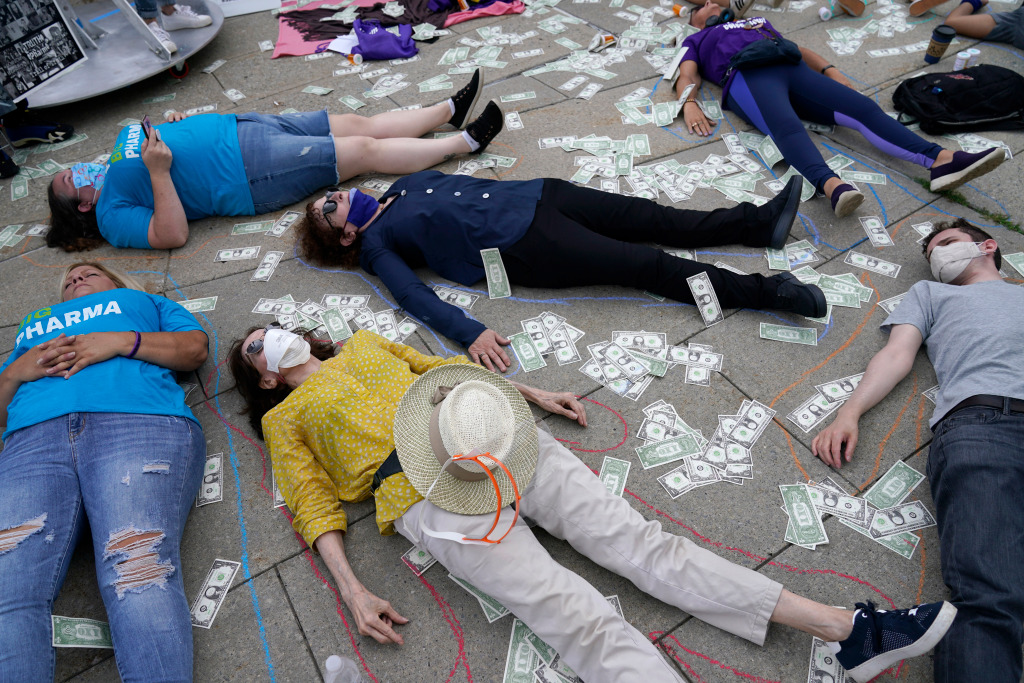 Protesters stage a die-in outside the courthouse where the Purdue Pharma bankruptcy is taking place in White Plains, N.Y. AP Photo/Seth Wenig
Protesters stage a die-in outside the courthouse where the Purdue Pharma bankruptcy is taking place in White Plains, N.Y. AP Photo/Seth Wenig
On Monday, demonstrators led by artist Nan Goldin built a symbolic graveyard in the plaza of a bankruptcy court in Westchester County to protest a proposed settlement for Purdue Pharma.
For the action, protestors brought cardboard tombstones bearing the names of friends and family whose lives had been claimed by the opioid epidemic in the United States, and lined them outside of the federal courthouse in White Plains, where the bankruptcy trial is set to begin on Thursday.
The protestors and others have decried the proposed settlement because it would shield members of the Sackler family, who are owners of Purdue, from future civil suits related to opioid deaths. (Over the past 20 years, there have been more than half a million opioid-related deaths.) The proposed deal would also see members of the Sackler family settle the thousands of cases against them by paying $4.5 billion of their personal fortune over the next nine years and relinquishing ownership of Purdue Pharma. The company has also agreed to make millions of documents available.
“[While] this deal is not perfect, we are delivering $4.5 billion into communities ravaged by opioids on an accelerated timetable and it gets one of the nation’s most harmful drug dealers out of the opioid business, once and for all,” New York State Attorney General Letitia James said in a statement in July.
Since 2018, Nan Goldin, who previously had an opioid addiction, and her activist group P.A.I.N. (Prescription Addiction Intervention Now) have orchestrated dozens of actions at museums worldwide, including the Guggenheim Museum in New York, the Smithsonian Institution in Washington, D.C., and the Harvard Art Museums in Massachusetts, all of which had previously accepted donations from members of the Sackler family, one of the world’s leading arts philanthropists. Often, the group will stage a “die-in” inside the galleries or on the museum steps, lying amid fake prescription bottles.
As a result of these protests, many art institutions have since distanced themselves from the Sackler name. Institutions such as the Louvre in Paris and the Serpentine Galleries in London have since removed or deemphasized the Sackler name from major gallery wings, while the Metropolitan Museum of Art in New York and the U.K.’s Tate museum system have said they will no longer accept donations from the family.
Previously, more than 20 state attorneys had pushed for an amendment to the settlement that would allow nonprofits to remove the Sackler name from its spaces without the fear of legal repercussions. (In some cases, large financial donations carry binding stipulations such as naming rights which, if violated, could cause the nonprofit to lose the donated money.) The concession is absent from the proposed bankruptcy restructuring plan. Instead, members of the Sackler family would be barred from requesting or permitting new naming rights in connection to charitable donations over the next nine years.
Outside the bankruptcy court in White Plains, Goldin and fellow protestors unfurled banners calling the proceedings “morally bankrupt.” As of yet, members of the Sackler family have not been criminally charged for their role in Purdue’s sale of OxyContin and the resulting opioid epidemic.
“As the Sacklers were ousted from museums, they went looking for protection from another institution that has long favored the wealthy and powerful: the US court system,” Goldin wrote in an op-ed for the Art Newspaper in 2020. “There, they are protected by a flotilla of the most expensive lawyers who have engineered a bankruptcy deal that will grant them immunity from future liability. It is clear that there are two justice systems: one for the billionaires and one for the rest of us.”
Source link : https://www.artnews.com/art-news/news/nan-goldin-sackler-family-settlement-protest-1234601324












